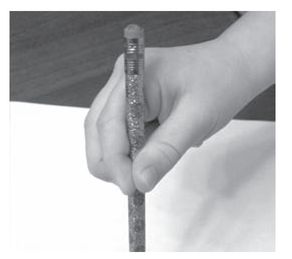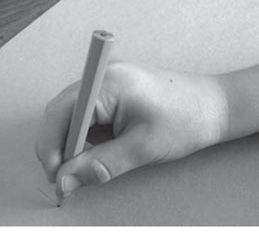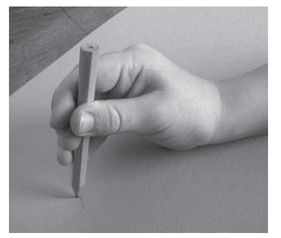Everyday Play (12 page)
Authors: Christy Isbell
Treasure Box
More Fun!




Strengthens your child’s grasp
What You Needjewelry boxes or small boxes with lids | various small items for decorating boxes such as sequins, tiny beads, and buttons | small paintbrushes or cotton swabs | glue | coins
What to Do• Encourage your child to use paintbrushes or cotton swabs to paint his treasure box with glue.
• After he finishes painting it, he can decorate it.
• Separate the box lid and bottom to let them dry separately.
• When the box and lid are dry, put the lid back on the box, and then give your child several coins to place in the box.
• Tell him to “bury the treasure” by hiding the treasure box somewhere in the room or nearby outside. You become a treasure hunter as you try to find the buried treasure.
• Take turns hiding the box and searching for it.
• Provide paper and markers or pencils for him to draw “treasure maps” to help the treasure hunter find the hidden treasure.
Chapter 6
Answers to Frequently Asked Questions from Parents
When should my child have an established “handedness?”
Most three- and four-year-olds will have an obvious hand preference. However, as children are developing their
bilateral
(both) hand skills during the fifth year of life, they may alternate use of hands. Most children have a well-established hand preference for fine motor activities by age six.
bilateral
(both) hand skills during the fifth year of life, they may alternate use of hands. Most children have a well-established hand preference for fine motor activities by age six.
Should my preschooler use “fat” or “skinny” pencils?
Three-year-old children should typically use large writing and drawing utensils. Their small fingers and less-developed grasps will work best with bigger tools like large markers and paintbrushes. Give your four- or five-year-old child a variety of smaller writing utensils such as normal-sized pencils, golf pencils, small crayons, thin markers, and small paintbrushes. These little tools will promote a better grasp and improved coordination.
What type of paper is best for cutting?
For preschoolers who are just learning to cut, thick paper works best. Suggestions include construction paper, card stock, magazine inserts (cards), brown paper bags, and index cards. Once your preschooler is able to cut stiff paper easily, he may then progress to standard paper. Use thin paper, such as foil, wax paper, magazines, or newspaper when your child is adept at using scissors and standard paper. Make sure the scissors are sharp and that they open and close smoothly so that your child will be successful with cutting.
When should my child use an adult-like grasp of the pencil?
The majority of children between the ages of 4 ½ and 6 years will use a mature grasp of writing utensils. This adult-like grasp typically means that your child holds the pencil with her fingertips and has good control of the pencil. Your child’s grasp will be influenced by a variety of things such as experience, eye-hand coordination, and muscle tone.
What is the best type of pencil grasp for my preschooler to use?
Typically, three-year-old children will use a
digital pronate grasp
(held with fingers; wrist straight; forearm moves with hand) OR a
static tripod posture
(held with thumb, index, and middle fingers in crude manner; ring and pinky fingers are slightly bent; held high up on pencil). Either of these grasps will work effectively for a three-year-old child who is gaining experience holding writing utensils.
digital pronate grasp
(held with fingers; wrist straight; forearm moves with hand) OR a
static tripod posture
(held with thumb, index, and middle fingers in crude manner; ring and pinky fingers are slightly bent; held high up on pencil). Either of these grasps will work effectively for a three-year-old child who is gaining experience holding writing utensils.

Digital pronate grasp

Static tripod grasp
There are several grasps that are considered efficient (most effective) for four- and five-year-olds. These grasps include two main components:
1. Fingertips on the end of the pencil.
2. An open space between the thumb and fingers (thumb and fingers form a circular position, so that you can see the palm of the hand).
Many children prefer to use a
dynamic tripod grasp
, holding the writing utensil between the thumb, index, and middle fingers. A
quadripod grasp
that incorporates the thumb, index, middle, and ring fingers is another effective and commonly used grasp.
dynamic tripod grasp
, holding the writing utensil between the thumb, index, and middle fingers. A
quadripod grasp
that incorporates the thumb, index, middle, and ring fingers is another effective and commonly used grasp.
When should my child be able to tie his shoes?
Most children learn to tie their shoes sometime during kindergarten. At this time, a child will usually have the bilateral hand skills, grasp, and eye-hand coordination necessary to complete this complex self-help skill. A child who wears primarily slip-on or Velcro-closure shoes will lack the experience with tying shoes and may develop this skill later.

Dynamic tripod grasp

Quadripod grasp
When should my child be able to write her name?
Many five-year-olds are able to write their first names independently. Most children learn to write their names in uppercase letters before lowercase letters. Some five-year-olds will also be able to write a few letters that are not in their first names, but which the children find interesting (for example, “M,” “O,” “M”).
What if my preschooler writes his name backwards?
It is typical for preschoolers to write letters backwards or to orient their names backwards across the page. This is an appropriate step for young children during the learning process. Many children demonstrate letter reversals up until the end of first grade. Four- and five-year-olds need opportunities to observe, imitate, and copy letters and words in a literacy-rich environment that includes books, signs, labels, and other reading materials.
If my preschooler holds her pencil awkwardly, should I try to change her grasp?
It is important first to consider your child’s age and developmental level. It would not be uncommon for a young, inexperienced preschooler to use what may look like an awkward grasp of a pencil. Young preschoolers may also grasp a pencil in a different way each time they hold one. Grasp is based on habit. So, whatever grasp the child consistently uses in later preschool and kindergarten will probably be the grasp she uses into adulthood. Make sure your child is using the appropriate size pencil. If your four- or five-year-old child consistently holds utensils with an awkward and inappropriate grasp, demonstrate the proper way to grasp a writing tool and gently reposition the pencil in the child’s hand. You could try introducing your child to a pencil grip (such as a triangle-shaped grip) to help her learn to hold the pencil more appropriately.
What if my preschooler holds his scissors upside down?
It is typical for two- and three-year-olds to hold scissors upside down. Preschoolers often use this pattern if they have not had enough experience with pre-scissor activities. Provide your child with pre-scissor activities, such as picking up objects with tongs, squeezing water through turkey basters, or using a hole-punch on paper. Be sure to model the proper way to hold scissors and you may give “thumb on top” verbal reminders. With enough practice, your preschooler will develop the next stage of scissor use—holding the scissors appropriately and snipping paper.
When is it appropriate to begin teaching my child how to write the letters of the alphabet?
Children should be able to copy simple lines, shapes, and their first names before practicing the proper formation of uppercase and lowercase letters of the alphabet. Most children are not developmentally ready to begin handwriting
instruction until the second half of kindergarten. Your child should not use handwriting workbook pages. Instead, provide your child with a variety of materials that include the alphabet and words, so that she has something to copy, if she so desires. You may begin by selecting a simple word or words that are interesting for your child such as “dog” or “love.”
instruction until the second half of kindergarten. Your child should not use handwriting workbook pages. Instead, provide your child with a variety of materials that include the alphabet and words, so that she has something to copy, if she so desires. You may begin by selecting a simple word or words that are interesting for your child such as “dog” or “love.”
What type of paper is appropriate for my preschooler to use when writing?
Preschoolers should write on plain paper with no lines. Most four- and five-year-olds do not have the visual perceptual skills or the fine motor control necessary to write letters accurately on a line or between two lines. Elementary paper that includes the dotted line in the middle of two solid lines is even more visually confusing than wide-ruled paper, and so it is best not to use it at all during the preschool years.
What if my child is using fine motor skills that I feel are well below age-appropriate level?
If you are concerned about your child’s participation in fine motor activities, you should discuss your concerns with your child’s pediatrician. You may contact your local school system’s
Child Find Program
or Special Education Program to request an evaluation. Your child should receive an occupational therapy evaluation to assess thoroughly his fine motor abilities. An occupational therapist (OT) who specializes in fine motor development can make recommendations for you to use at home and can also provide fine motor intervention for your preschooler.
Child Find Program
or Special Education Program to request an evaluation. Your child should receive an occupational therapy evaluation to assess thoroughly his fine motor abilities. An occupational therapist (OT) who specializes in fine motor development can make recommendations for you to use at home and can also provide fine motor intervention for your preschooler.
Glossary
Bilateral Hand Skills
: The ability to use both hands together to accomplish a task.
: The ability to use both hands together to accomplish a task.
Child Find Program
: A publicly-funded program under the Individuals with Disabilities Education Act (IDEA) intended to identify, locate, and evaluate/assess infants and toddlers with potential developmental delays or disabilities.
: A publicly-funded program under the Individuals with Disabilities Education Act (IDEA) intended to identify, locate, and evaluate/assess infants and toddlers with potential developmental delays or disabilities.
Cognitive Development
:The process of thinking, learning, perception, and reasoning.
:The process of thinking, learning, perception, and reasoning.
Developmentally Appropriate
: Activities and educational experiences that match the child’s age and stage of development.
: Activities and educational experiences that match the child’s age and stage of development.
Digital Pronate Grasp
: Object is held with all fingers, wrist straight, and forearm moves with hand. Typical grasp for 2- to 3-year-olds.
: Object is held with all fingers, wrist straight, and forearm moves with hand. Typical grasp for 2- to 3-year-olds.
Other books
Revenge of the Rose by Michael Moorcock
From the Ashes by Jeremy Burns
Unfiltered & Unsaved by Payge Galvin, Bridgette Luna
Deception by Christiane Heggan
By the Light of the Silvery Moon by Goyer, Tricia
The Long Earth by Terry Pratchett, Stephen Baxter
The Seekers: The Story of Man's Continuing Quest to Understand His World by Daniel J. Boorstin
Being Human by Patricia Lynne
Desire and Duty by Marie Medina
Gut Instinct by Brad Taylor